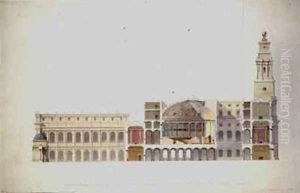Walter L.B. Granville Paintings
Walter L. B. Granville was a British architect, not widely known outside of professional circles, whose work was primarily focused on building designs in India during the British Raj. Born in 1819, Granville is not remembered as a prolific artist but rather as a skilled architect whose contributions to the colonial urban landscape of India were significant during his tenure as an architect in the subcontinent.
Granville's architectural career is most notable for his work in Kolkata (formerly Calcutta), where he served as the government architect. During his time there, he was responsible for designing several important public buildings that reflected the grandeur and imperial aspirations of the British Empire. His style was characterized by a blend of neoclassical and gothic revival elements, which was quite popular during the Victorian era.
One of Granville's most famous works is the Calcutta High Court, which is the oldest High Court in India. Completed in 1872, it remains a functioning courthouse and is a fine example of gothic revival architecture. Another significant project of his was the design of the Indian Museum in Kolkata, which is the largest and oldest museum in India and showcases a vast collection of Indian natural history and Indian art.
Despite his contributions to the architectural landscape of Kolkata, Granville's work and life have not been the subject of extensive scholarship, and as such, detailed biographical information is relatively sparse. He passed away in 1874, leaving behind a legacy of stately public buildings that continue to serve as functional spaces and as reminders of the architectural ambitions of the British Raj in India.
